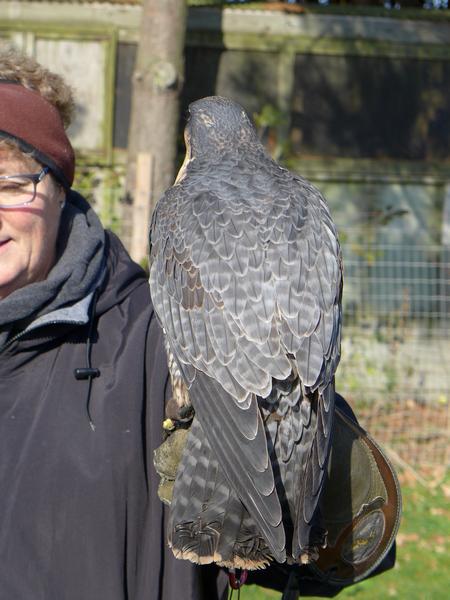
Now’s a good time to brush up on identifying peregrine falcons since they pass by hawk watches in October, especially on the coast. When you identify a peregrine you can also tell how old it is because the plumage is different in each age group: adult, juvenile, and sub-adult.
Plumage provides an exact age for two groups in October: Juveniles are first year birds, 6 months old, that hatched last spring. Sub-adults are second year birds, 18 months old, with nearly complete adult plumage.
Adults — two or more years old — all have the same plumage. Unfortunately you can’t know an adult’s exact age unless the bird is banded and you find out its provenance.
Here’s what they look like:
Adult peregrines (2+ years old in October) have fresh plumage in charcoal gray and white. The photo at top shows an adult male in flight. The photo below is an adult female. Adults have:
- Solid dark charcoal helmet (head)
- Dark charcoal malar stripes (on face)
- Clean white or slightly rosy chest and throat
- Horizontal charcoal+white stripes on belly and flanks
- Gray back: Male’s is pale blue-gray. Female’s is “muddy” gray.

Juvenile peregrines (6 months old in October) are the same size as adults but their colors are brown+cream. Juveniles have:
- Variable brown helmet with some cream-colored traces (head)
- Brown malar stripes (on face)
- Cream colored chest that’s striped all the way up to the throat
- Vertical brown+cream stripes on belly and flanks
- Brown back.
- (Bonus!) Juveniles have cream-colored tips on their tails, visible as the sun shines through them in flight.

Above, a juvenile in flight. Below a juvenile shows off the vertical stripes on his chest and belly. His variable brown helmet with “eyes on the back of his head” and horizontal cream-colored line at his crown.

Sub-adults are 18 months old with nearly complete adult plumage except for a few juvenile feathers. They began to molt into adult plumage last spring at 10-12 months old. By October their few juvenile feathers are hard to see without a photograph. They are ready to breed next spring.
Below, an 18-month-old peregrine named Spirit is in rehab at Medina Raptor Center in the autumn of 2014. You can see her back is mostly gray with just a few brown feathers. Her head shows faint traces of the juvenile cream colors.

For a view of sub-adult plumage in the spring, see these photos taken in March 2016 of a 10-month-old Juvenile Peregrine Falcon Transitioning Into Adult Plumage.
For additional tips, see Ageing Peregrine Falcons in the Field by Alex Lamoreaux at Nemesis Bird.
(all photos taken at University of Pittsburgh by Peter Bell … except for the peregrine on the glove, “Spirit” at Medina Raptor Center, photo by Kate St. John)
Hi Kate,
FYI: My wife is an Allegheny County Police officer at the Pittsburgh International Airport. Yesterday, she saw an adult Peregrine Falcon on the public arrivals area sitting on a wall between the Landside Terminal and the parking garage. Using her cell phone, she got a video and several still pictures of the bird. She was not able to get close enough to see if there were any leg bands. She also said she has seen possibly the same bird for the past six months. It has made repeated passes around the area possibly trying to grab one of the numerous pigeons that roost in the steel beams. However, she has not seen any evidence of a nest.
Thought you’d like to know.
Ed Shott
Speaking of peregrine migration, this report was posted by ‘Dave’ on PABIRDS on 10/10/2017 with the title, “Totally cool peregrine at Bake Oven Knob, Lehigh County”:
http://birding.aba.org/message.php?mesid=1343440&MLID=PA01&MLNM=Pennsylvania
“While up at Bake Oven Knob today for the Fall raptor migration we had an awesome peregrine make a brief but exciting visit.
Richard spotted this bird in level flight over what we call the Notch. It was up a bit and flew without flapping at a good pace. This bird was probably slightly north of the ridge center line. We noticed that it had what appeared to be a full crop.
The bird continued to glide to a spot just a little bit past our position It suddenly pulled in its wings and made a hard 90 degree left turn towards the area behind the lookout where we were sitting . It dove and in an instant it quickly accelerated to a speed over 100 mph. We could hear a pretty loud rush of air associated with its motion as it was so close.
As it approached the mountain it flared and landed in a dead tree about 75 feet past the lookout. It didn’t stay long as it probably looked over and saw a bunch of stunned hawkwatchers staring over at it.
Happy Birding,
Dave”
we also live in Pgh Pa right in the west end elliot area
for the past 3 yrs Ive had the same falcon coming to hunt pigeons in my yard rats in the alley & abandoned garages..
he swooped into my yard at 200 mph last year he caught & ate a pigeon even when a car pulled in he didnt stop eating the bird just thinks this is his yard & he can have it its a beautiful bird & he keeps the pigeons away every winter
When do falcon start drinking water
Wild peregrines drink water but they don’t need as much water as you’d think. Gruesome as it sounds, they get water from the moisture in their prey.